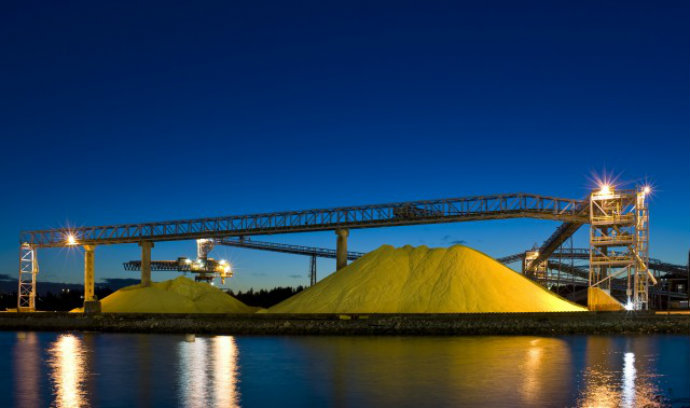Helping sulfur reach its potential

Millions of tons of sulfur, including these mounds in British Columbia, are generated each year by the refining of fossil fuels. Jonas Baltrusaitis is developing a sustainable method of processing sulfur into sulfuric acid that can be used in fertilizers. (Photo courtesy of Corbis Images)
Alongside the world’s major oil and natural gas refineries, says Jonas Baltrusaitis, deposits of sulfur are growing larger and larger each year. One mountain of sulfur in Kazakhstan, he says, has even been photographed from space shuttles orbiting the earth.
Elemental sulfur today occurs chiefly as a by-product of the refining of petroleum and natural gas. By itself, sulfur is nonreactive, but as part of the compound sulfuric acid (H2SO4), it is a critical ingredient in nitrogen-based phosphate fertilizers that enrich the soil and enhance the growth of crops.
Baltrusaitis, an assistant professor of chemical and biomolecular engineering, wants to develop a sustainable method of processing sulfur into sulfuric acid that would “bridge the gap” between the unused mounds of sulfur and the demand for H2SO4 in fertilizers.
He is seeking to determine the optimal proportions of urea, sulfuric acid and water in fertilizers while achieving the nitrogen-to-sulfur ratio at which fertilizers work most efficiently. Urea is a nitrogen-based, water-soluble compound.
Fertilizers with lower crystallization temperatures work better in cold climates, while those that crystallize at higher temperatures are better suited for warmer climates. So Baltrusaitis also measures the temperatures at which phase changes from liquid to solid occur in various types of fertilizer.
The overall goal of his research is to develop and test fertilizers that improve crop yield and help meet global food demands, which he says are projected to rise 40 percent by 2030.
Baltrusaitis recently published an article about his research for the American Chemical Society’s Journal of Sustainable Chemistry and Engineering. Titled “Liquid and Solid Compound Granulated Diurea Sulfate-Based Fertilizers for Sustainable Sulfur Source,” the article was coauthored with A.M. Sviklas and J. Galeckiene of the Kaunas University of Technology in Lithuania.
“Everything ties together”
Baltrusaitis conducts his research at what he calls the “nexus of energy and environment,” where many factors combine to affect the amount of food humans are able to grow on arable land.
For several reasons, he says, the amount of sulfur in soils worldwide is falling. Oceanic emissions of dimethyl sulfate—which eventually fall on land—are decreasing because of climate change and because of acidification caused by the oceans’ uptake of increasing amounts of man-made carbon dioxide emissions.
A second reason for the decline of sulfur content in soil is an irony: In an effort to curb acid rain, many countries have enacted regulations limiting sulfur content in gasoline and other fuels—thus decreasing the sulfur content in rain.
Meanwhile, an estimated 60 million tons of elemental sulfur each year are piling up next to petroleum and natural gas refineries as humans gradually exhaust deposits of low-sulfur-content oil and gas and begin to tap resources with higher amounts of sulfur.
These factors, says Baltrusaitis, make it imperative to process elemental sulfur into sulfuric acid that can be incorporated into nitrogen-based phosphate fertilizers that work in both cold and warm climates.
“Instead of returning sulfur to the environment, we’re depleting it and storing it,” he says. “I want to take sulfuric acid and scale it up and make fertilizer. My goal is to return sulfur to the environment in its reactive form, as sulfuric acid, so it can be absorbed by plants and increase the efficiency of soil in uptaking nutrients.
“The more efficient we can make this uptake process, the greater the crop yields we will have.”
In his research, Baltrusaitis constructs phase diagrams to measure the temperature at which nitrogen and sulfur crystallize. He works with a fertilizer based on diurea sulfate, a compound high in nitrogen and sulfur content. His goal is to make liquid and compound-granulated fertilizers that have a nitrogen-to-sulfur ratio of 15:1.
“We combine urea, sulfuric acid and water in different proportions and try to determine the optimum temperatures for phase changes to occur from liquid to solid,” he says.
Baltrusaitis also measures the physical properties—pH, dynamic viscosity and density—of the diurea sulfate-based liquid fertilizer as well as properties related to granulation and caking.
The method that his group uses to make liquid and compound-granulated fertilizers, Baltrusaitis wrote in his ACS article, “effectively utilizes existing scalable H2SO4 production technologies…[and] avoids the unsustainable use of sulfate minerals.”
The results achieved by Baltrusaitis’s group promise to benefit the environment as well as crop yields.
Soil that contains insufficient amounts of sulfur, he says, loses its ability to absorb nitrogen and other nutrients. As a result, crops receive less than optimum nutrition, while nitrates wash away and end up polluting streams and rivers.
“Soil needs sulfur to uptake nitrogen,” says Baltrusaitis. “Without sulfur, nitrogen is not taken up but dissolved in water and washed away. The results are algae blooms in water bodies, fish dying because of the lack of oxygen, and the eutrophication of the environment.
“Everything ties together.”
Posted on:

